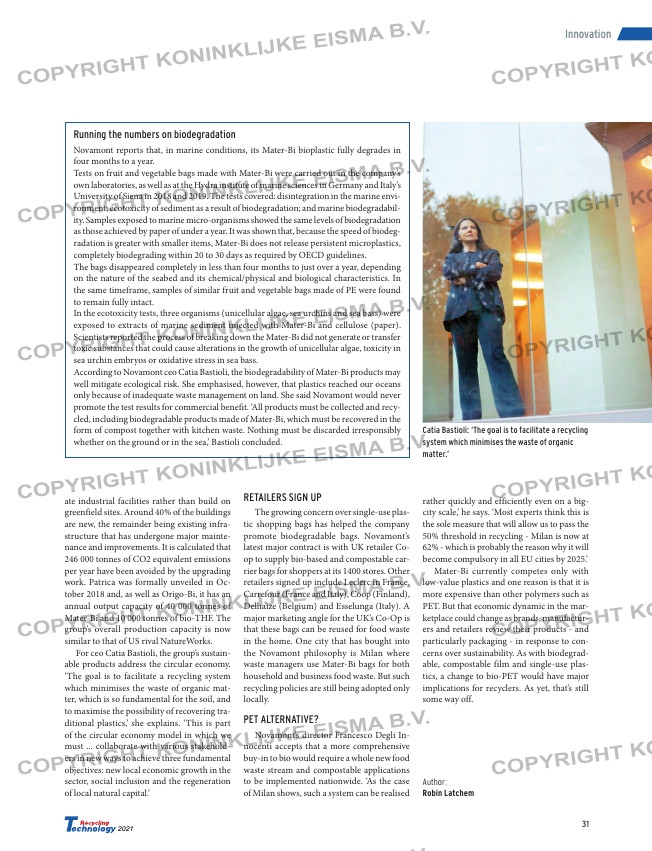Page 31 from: Out now: Recycling Technology 2021!

31
2021
Innovation
ate industrial facilities rather than build on
greenfield sites. Around 40% of the buildings
are new, the remainder being existing infra-
structure that has undergone major mainte-
nance and improvements. It is calculated that
246 000 tonnes of CO2 equivalent emissions
per year have been avoided by the upgrading
work. Patrica was formally unveiled in Oc-
tober 2018 and, as well as Origo-Bi, it has an
annual output capacity of 40 000 tonnes of
Mater-Bi and 10 000 tonnes of bio-THF. The
group’s overall production capacity is now
similar to that of US rival NatureWorks.
For ceo Catia Bastioli, the group’s sustain-
able products address the circular economy.
‘The goal is to facilitate a recycling system
which minimises the waste of organic mat-
ter, which is so fundamental for the soil, and
to maximise the possibility of recovering tra-
ditional plastics,’ she explains. ‘This is part
of the circular economy model in which we
must … collaborate with various stakehold-
ers in new ways to achieve three fundamental
objectives: new local economic growth in the
sector, social inclusion and the regeneration
of local natural capital.’
RETAILERS SIGN UP
The growing concern over single-use plas-
tic shopping bags has helped the company
promote biodegradable bags. Novamont’s
latest major contract is with UK retailer Co-
op to supply bio-based and compostable car-
rier bags for shoppers at its 1400 stores. Other
retailers signed up include Leclerc in France,
Carrefour (France and Italy), Coop (Finland),
Delhaize (Belgium) and Esselunga (Italy). A
major marketing angle for the UK’s Co-Op is
that these bags can be reused for food waste
in the home. One city that has bought into
the Novamont philosophy is Milan where
waste managers use Mater-Bi bags for both
household and business food waste. But such
recycling policies are still being adopted only
locally.
PET ALTERNATIVE?
Novamont’s director Francesco Degli In-
nocenti accepts that a more comprehensive
buy-in to bio would require a whole new food
waste stream and compostable applications
to be implemented nationwide. ‘As the case
of Milan shows, such a system can be realised
rather quickly and efficiently even on a big-
city scale,’ he says. ‘Most experts think this is
the sole measure that will allow us to pass the
50% threshold in recycling – Milan is now at
62% – which is probably the reason why it will
become compulsory in all EU cities by 2025.’
Mater-Bi currently competes only with
low-value plastics and one reason is that it is
more expensive than other polymers such as
PET. But that economic dynamic in the mar-
ketplace could change as brands, manufactur-
ers and retailers review their products – and
particularly packaging – in response to con-
cerns over sustainability. As with biodegrad-
able, compostable film and single-use plas-
tics, a change to bio-PET would have major
implications for recyclers. As yet, that’s still
some way off.
Author:
Robin Latchem
Catia Bastioli: ‘The goal is to facilitate a recycling
system which minimises the waste of organic
matter.’
Running the numbers on biodegradation
Novamont reports that, in marine conditions, its Mater-Bi bioplastic fully degrades in
four months to a year.
Tests on fruit and vegetable bags made with Mater-Bi were carried out in the company’s
own laboratories, as well as at the Hydra institute of marine sciences in Germany and Italy’s
University of Siena in 2018 and 2019. The tests covered: disintegration in the marine envi-
ronment; ecotoxicity of sediment as a result of biodegradation; and marine biodegradabil-
ity. Samples exposed to marine micro-organisms showed the same levels of biodegradation
as those achieved by paper of under a year. It was shown that, because the speed of biodeg-
radation is greater with smaller items, Mater-Bi does not release persistent microplastics,
completely biodegrading within 20 to 30 days as required by OECD guidelines.
The bags disappeared completely in less than four months to just over a year, depending
on the nature of the seabed and its chemical/physical and biological characteristics. In
the same timeframe, samples of similar fruit and vegetable bags made of PE were found
to remain fully intact.
In the ecotoxicity tests, three organisms (unicellular algae, sea urchins and sea bass) were
exposed to extracts of marine sediment injected with Mater-Bi and cellulose (paper).
Scientists reported the process of breaking down the Mater-Bi did not generate or transfer
toxic substances that could cause alterations in the growth of unicellular algae, toxicity in
sea urchin embryos or oxidative stress in sea bass.
According to Novamont ceo Catia Bastioli, the biodegradability of Mater-Bi products may
well mitigate ecological risk. She emphasised, however, that plastics reached our oceans
only because of inadequate waste management on land. She said Novamont would never
promote the test results for commercial benefit. ‘All products must be collected and recy-
cled, including biodegradable products made of Mater-Bi, which must be recovered in the
form of compost together with kitchen waste. Nothing must be discarded irresponsibly
whether on the ground or in the sea,’ Bastioli concluded.
28-29-30-31_research-novamont.indd 31 09-09-20 09:58



